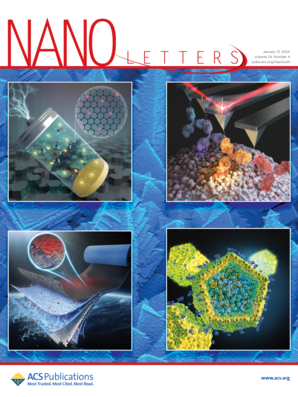Tetraspanin 4 Mediates Cholesterol-Dependent Exosome Membrane Protection from Cryodamage.
IF 9.6
1区 材料科学
Q1 CHEMISTRY, MULTIDISCIPLINARY
引用次数: 0
Abstract
Exosomes, nanosized extracellular vesicles carrying proteins, lipids, and nucleic acids, hold great potential in therapeutic applications. Cryopreservation, a widely used method for their preservation and transport, often causes irreversible damage. Understanding the molecular mechanisms underlying biomembrane resistance to cryodamage is crucial for advancing cryopreservation techniques. In this study, we find that tetraspanin 4 (TSPAN4) and other tetraspanin family proteins play an essential role in protecting exosomes from cryodamage, likely due to their role in cholesterol binding and membrane microdomain formation. Furthermore, we engineered TSPAN4-loaded exosomes, which demonstrated enhanced cryoprotection while maintaining a similar protein composition and uptake efficiency compared to wild-type exosomes. Our novel cryopreservation strategy, which does not rely on external agents, offers a promising approach for advancing the clinical translation of exosomes as therapeutic agents.四蛋白4介导胆固醇依赖性外泌体膜对低温损伤的保护。
外泌体是纳米大小的细胞外囊泡,携带蛋白质、脂质和核酸,在治疗应用中具有巨大的潜力。冷冻保存是一种广泛使用的保存和运输方法,经常造成不可逆转的损害。了解生物膜抗低温损伤的分子机制对推进低温保存技术至关重要。在这项研究中,我们发现tetraspanin 4 (TSPAN4)和其他tetraspanin家族蛋白在保护外泌体免受低温损伤方面发挥着重要作用,这可能是由于它们在胆固醇结合和膜微结构域形成中的作用。此外,我们设计了装载tspan4的外泌体,与野生型外泌体相比,它在保持相似的蛋白质组成和摄取效率的同时表现出增强的冷冻保护作用。我们的新冷冻保存策略不依赖于外部药物,为推进外泌体作为治疗剂的临床翻译提供了一种有希望的方法。
本文章由计算机程序翻译,如有差异,请以英文原文为准。
求助全文
约1分钟内获得全文
求助全文
来源期刊

Nano Letters
工程技术-材料科学:综合
CiteScore
16.80
自引率
2.80%
发文量
1182
审稿时长
1.4 months
期刊介绍:
Nano Letters serves as a dynamic platform for promptly disseminating original results in fundamental, applied, and emerging research across all facets of nanoscience and nanotechnology. A pivotal criterion for inclusion within Nano Letters is the convergence of at least two different areas or disciplines, ensuring a rich interdisciplinary scope. The journal is dedicated to fostering exploration in diverse areas, including:
- Experimental and theoretical findings on physical, chemical, and biological phenomena at the nanoscale
- Synthesis, characterization, and processing of organic, inorganic, polymer, and hybrid nanomaterials through physical, chemical, and biological methodologies
- Modeling and simulation of synthetic, assembly, and interaction processes
- Realization of integrated nanostructures and nano-engineered devices exhibiting advanced performance
- Applications of nanoscale materials in living and environmental systems
Nano Letters is committed to advancing and showcasing groundbreaking research that intersects various domains, fostering innovation and collaboration in the ever-evolving field of nanoscience and nanotechnology.
 求助内容:
求助内容: 应助结果提醒方式:
应助结果提醒方式:


